Report: Physics Dynamics and Equilibrium in Aircraft Cruise
VerifiedAdded on 2022/09/07
|17
|3138
|21
Report
AI Summary
This report provides a comprehensive analysis of the physics dynamics governing the cruise stage of an aircraft's flight. It begins by detailing the four fundamental forces at play: thrust, lift, weight, and drag, explaining their interactions and how they achieve equilibrium during steady flight. The report further explores the influence of factors such as airspeed, angle of attack, and the aircraft's center of gravity on maintaining this equilibrium. It then delves into the crucial role of tailplanes, or horizontal stabilizers, in balancing and controlling these forces, specifically addressing the challenges associated with maintaining stability and preventing undesirable pitching moments. The report uses scientific principles and straightforward explanations to break down complex concepts. The report also touches on how changes in thrust, lift, and drag can affect the aircraft's stability. It considers the impact of the center of gravity and center of pressure on the aircraft's handling. The report concludes by explaining how pilots manage aircraft stability, including the use of the elevator and stabilizer trim. The report is designed to be a training resource for colleagues without aviation degrees, making it valuable for those seeking a clear understanding of aircraft flight mechanics.
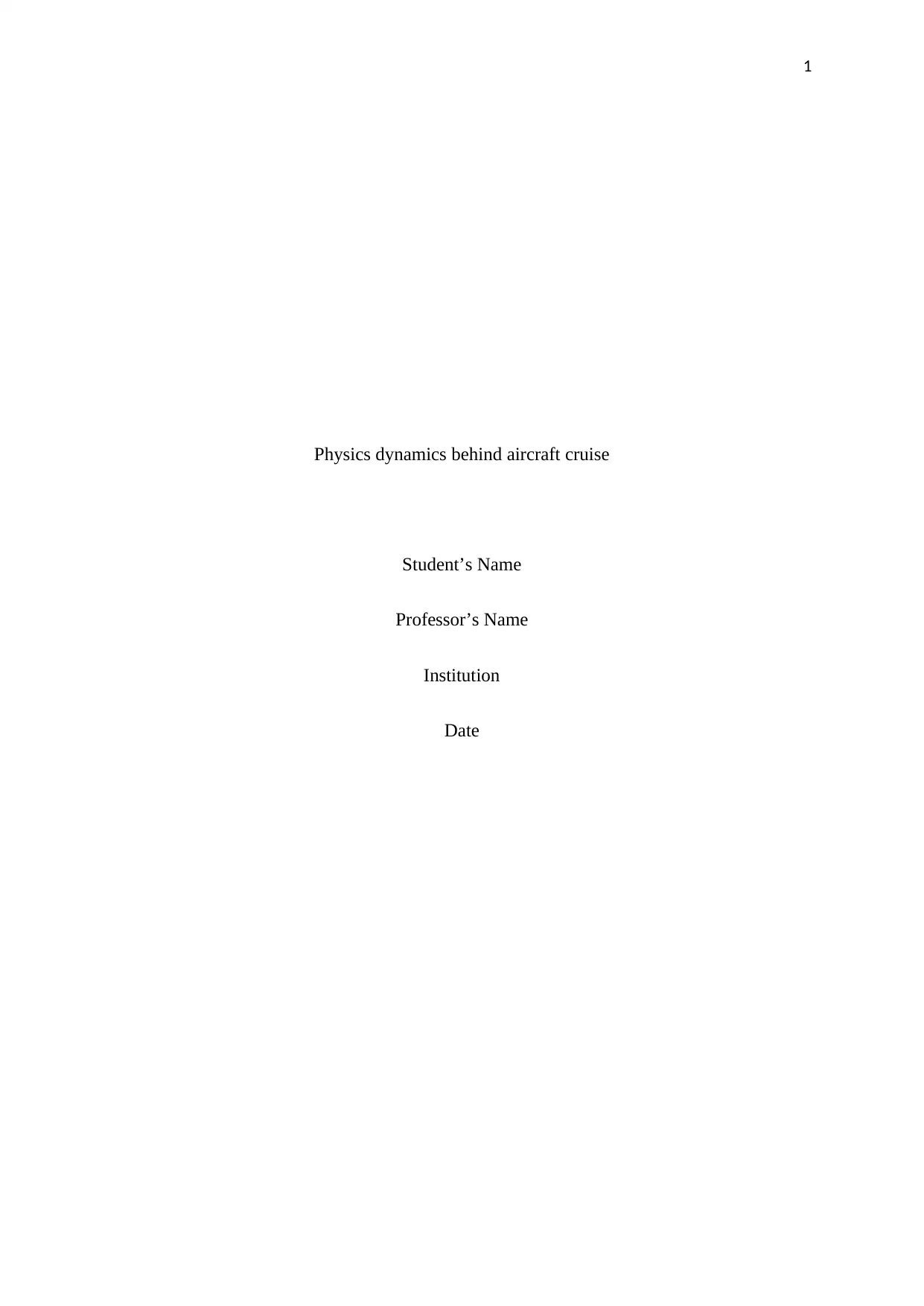
1
Physics dynamics behind aircraft cruise
Student’s Name
Professor’s Name
Institution
Date
Physics dynamics behind aircraft cruise
Student’s Name
Professor’s Name
Institution
Date
Paraphrase This Document
Need a fresh take? Get an instant paraphrase of this document with our AI Paraphraser
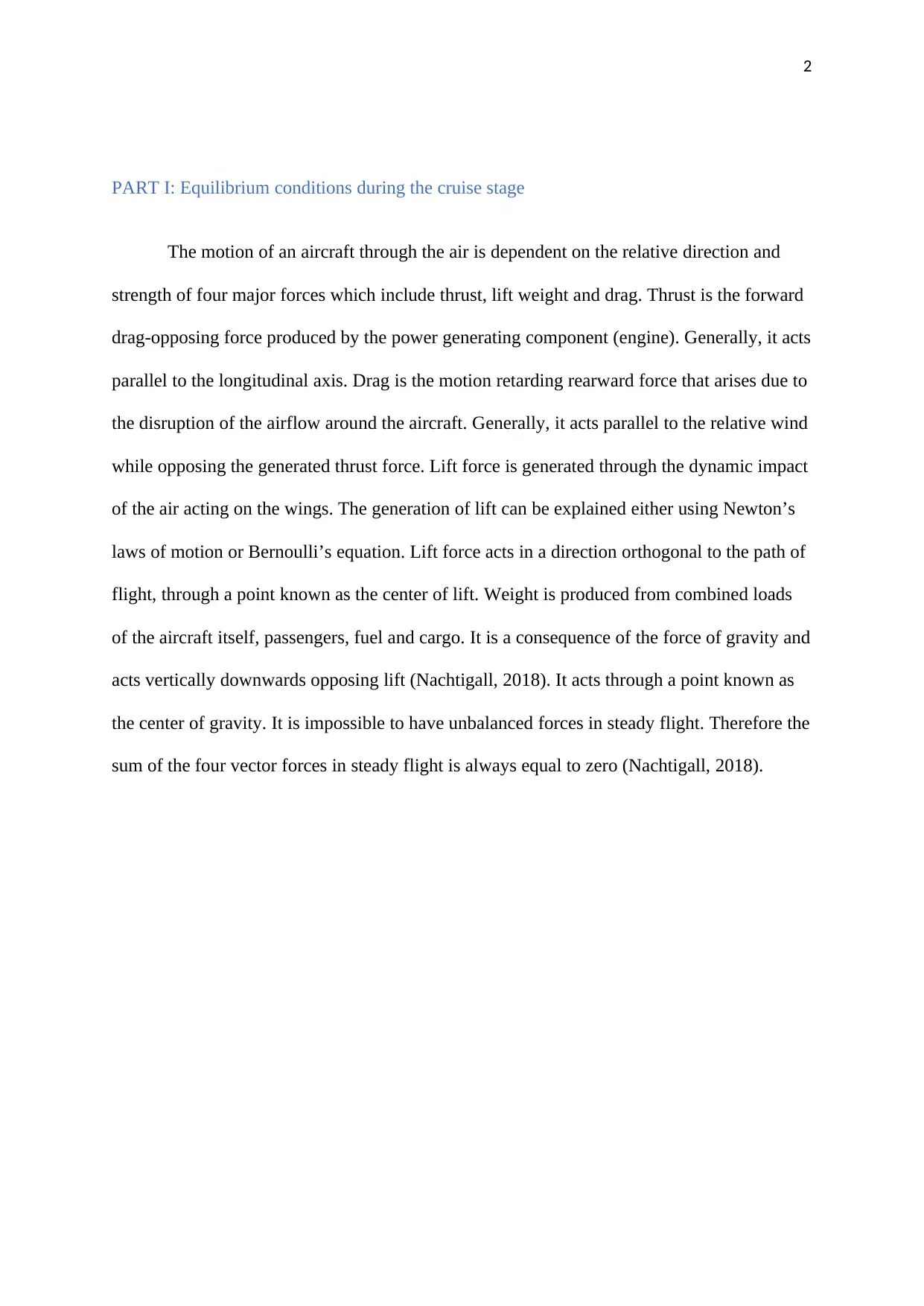
2
PART I: Equilibrium conditions during the cruise stage
The motion of an aircraft through the air is dependent on the relative direction and
strength of four major forces which include thrust, lift weight and drag. Thrust is the forward
drag-opposing force produced by the power generating component (engine). Generally, it acts
parallel to the longitudinal axis. Drag is the motion retarding rearward force that arises due to
the disruption of the airflow around the aircraft. Generally, it acts parallel to the relative wind
while opposing the generated thrust force. Lift force is generated through the dynamic impact
of the air acting on the wings. The generation of lift can be explained either using Newton’s
laws of motion or Bernoulli’s equation. Lift force acts in a direction orthogonal to the path of
flight, through a point known as the center of lift. Weight is produced from combined loads
of the aircraft itself, passengers, fuel and cargo. It is a consequence of the force of gravity and
acts vertically downwards opposing lift (Nachtigall, 2018). It acts through a point known as
the center of gravity. It is impossible to have unbalanced forces in steady flight. Therefore the
sum of the four vector forces in steady flight is always equal to zero (Nachtigall, 2018).
PART I: Equilibrium conditions during the cruise stage
The motion of an aircraft through the air is dependent on the relative direction and
strength of four major forces which include thrust, lift weight and drag. Thrust is the forward
drag-opposing force produced by the power generating component (engine). Generally, it acts
parallel to the longitudinal axis. Drag is the motion retarding rearward force that arises due to
the disruption of the airflow around the aircraft. Generally, it acts parallel to the relative wind
while opposing the generated thrust force. Lift force is generated through the dynamic impact
of the air acting on the wings. The generation of lift can be explained either using Newton’s
laws of motion or Bernoulli’s equation. Lift force acts in a direction orthogonal to the path of
flight, through a point known as the center of lift. Weight is produced from combined loads
of the aircraft itself, passengers, fuel and cargo. It is a consequence of the force of gravity and
acts vertically downwards opposing lift (Nachtigall, 2018). It acts through a point known as
the center of gravity. It is impossible to have unbalanced forces in steady flight. Therefore the
sum of the four vector forces in steady flight is always equal to zero (Nachtigall, 2018).
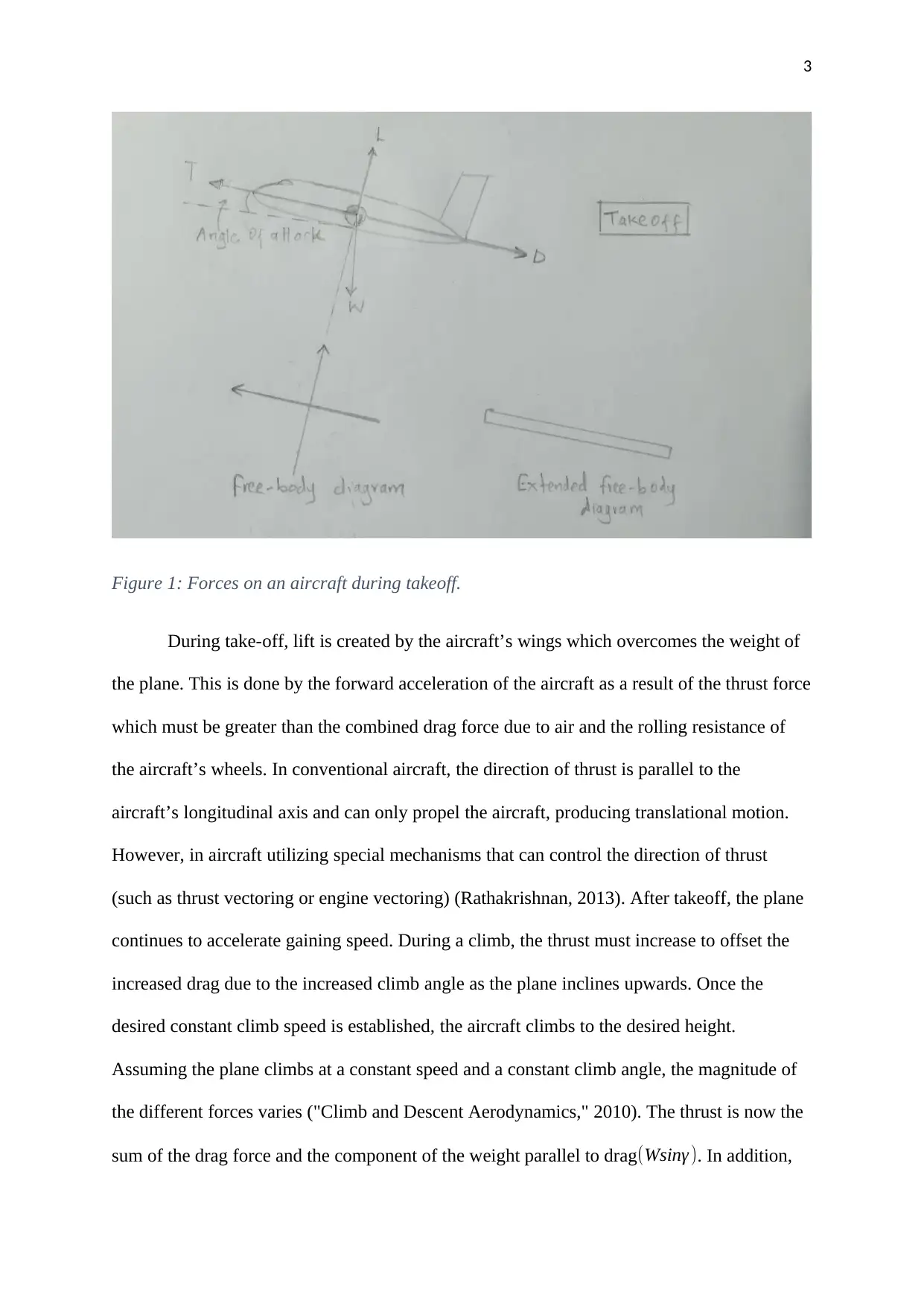
3
Figure 1: Forces on an aircraft during takeoff.
During take-off, lift is created by the aircraft’s wings which overcomes the weight of
the plane. This is done by the forward acceleration of the aircraft as a result of the thrust force
which must be greater than the combined drag force due to air and the rolling resistance of
the aircraft’s wheels. In conventional aircraft, the direction of thrust is parallel to the
aircraft’s longitudinal axis and can only propel the aircraft, producing translational motion.
However, in aircraft utilizing special mechanisms that can control the direction of thrust
(such as thrust vectoring or engine vectoring) (Rathakrishnan, 2013). After takeoff, the plane
continues to accelerate gaining speed. During a climb, the thrust must increase to offset the
increased drag due to the increased climb angle as the plane inclines upwards. Once the
desired constant climb speed is established, the aircraft climbs to the desired height.
Assuming the plane climbs at a constant speed and a constant climb angle, the magnitude of
the different forces varies ("Climb and Descent Aerodynamics," 2010). The thrust is now the
sum of the drag force and the component of the weight parallel to drag(Wsinγ ). In addition,
Figure 1: Forces on an aircraft during takeoff.
During take-off, lift is created by the aircraft’s wings which overcomes the weight of
the plane. This is done by the forward acceleration of the aircraft as a result of the thrust force
which must be greater than the combined drag force due to air and the rolling resistance of
the aircraft’s wheels. In conventional aircraft, the direction of thrust is parallel to the
aircraft’s longitudinal axis and can only propel the aircraft, producing translational motion.
However, in aircraft utilizing special mechanisms that can control the direction of thrust
(such as thrust vectoring or engine vectoring) (Rathakrishnan, 2013). After takeoff, the plane
continues to accelerate gaining speed. During a climb, the thrust must increase to offset the
increased drag due to the increased climb angle as the plane inclines upwards. Once the
desired constant climb speed is established, the aircraft climbs to the desired height.
Assuming the plane climbs at a constant speed and a constant climb angle, the magnitude of
the different forces varies ("Climb and Descent Aerodynamics," 2010). The thrust is now the
sum of the drag force and the component of the weight parallel to drag(Wsinγ ). In addition,
⊘ This is a preview!⊘
Do you want full access?
Subscribe today to unlock all pages.

Trusted by 1+ million students worldwide

4
the lift is less than the weight of the aircraft since it is given by the component of weight
perpendicular to the thrust force. Besides, the lift now depends on the angle of climb since
L=Wcosγ.
At the end of the climb, the aircraft attains level flight at the desired cruise speed.
Level flight requires a balance of the 4 forces acting on the aircraft. The thrust force equals
the drag force. The excess thrust is, therefore, zero and the aircraft cruises at a constant speed,
T −D=0
L−W =0
T =D
L=W
The lift force equals the weight of the aircraft under this condition. If the thrust force
becomes greater than drag, equilibrium is disturbed and the aircraft accelerates forward.
Increasing the thrust for an aircraft in level flight increases lift and the aircraft accelerates. If
the angle of attack is not decreased just enough to maintain the relationship between weight
and lift, the aircraft begins to climb. Therefore, as the airspeed changes due to change in
thrust, the angle of attack must be changed accordingly to maintain level flight. If the
aircraft’s weight exceeds the lift, the aircraft accelerates downwards while an excess of lift
accelerates the plane upwards. Most aircraft have their center of gravity located adjacent to
the center of pressure of the wing (Marques & Ronch 2017). For aircraft stability during level
flight, it is desirable to have the center of gravity in front of the center of pressure. The
location of the center of pressure behind the center of gravity the lift force produces a
counter-clockwise rotation about the center of gravity. Therefore, level flight requires
balancing of the torques produced by the tail and the wing. The lift is directly related to the
square of the velocity as given by the lift equation,
the lift is less than the weight of the aircraft since it is given by the component of weight
perpendicular to the thrust force. Besides, the lift now depends on the angle of climb since
L=Wcosγ.
At the end of the climb, the aircraft attains level flight at the desired cruise speed.
Level flight requires a balance of the 4 forces acting on the aircraft. The thrust force equals
the drag force. The excess thrust is, therefore, zero and the aircraft cruises at a constant speed,
T −D=0
L−W =0
T =D
L=W
The lift force equals the weight of the aircraft under this condition. If the thrust force
becomes greater than drag, equilibrium is disturbed and the aircraft accelerates forward.
Increasing the thrust for an aircraft in level flight increases lift and the aircraft accelerates. If
the angle of attack is not decreased just enough to maintain the relationship between weight
and lift, the aircraft begins to climb. Therefore, as the airspeed changes due to change in
thrust, the angle of attack must be changed accordingly to maintain level flight. If the
aircraft’s weight exceeds the lift, the aircraft accelerates downwards while an excess of lift
accelerates the plane upwards. Most aircraft have their center of gravity located adjacent to
the center of pressure of the wing (Marques & Ronch 2017). For aircraft stability during level
flight, it is desirable to have the center of gravity in front of the center of pressure. The
location of the center of pressure behind the center of gravity the lift force produces a
counter-clockwise rotation about the center of gravity. Therefore, level flight requires
balancing of the torques produced by the tail and the wing. The lift is directly related to the
square of the velocity as given by the lift equation,
Paraphrase This Document
Need a fresh take? Get an instant paraphrase of this document with our AI Paraphraser
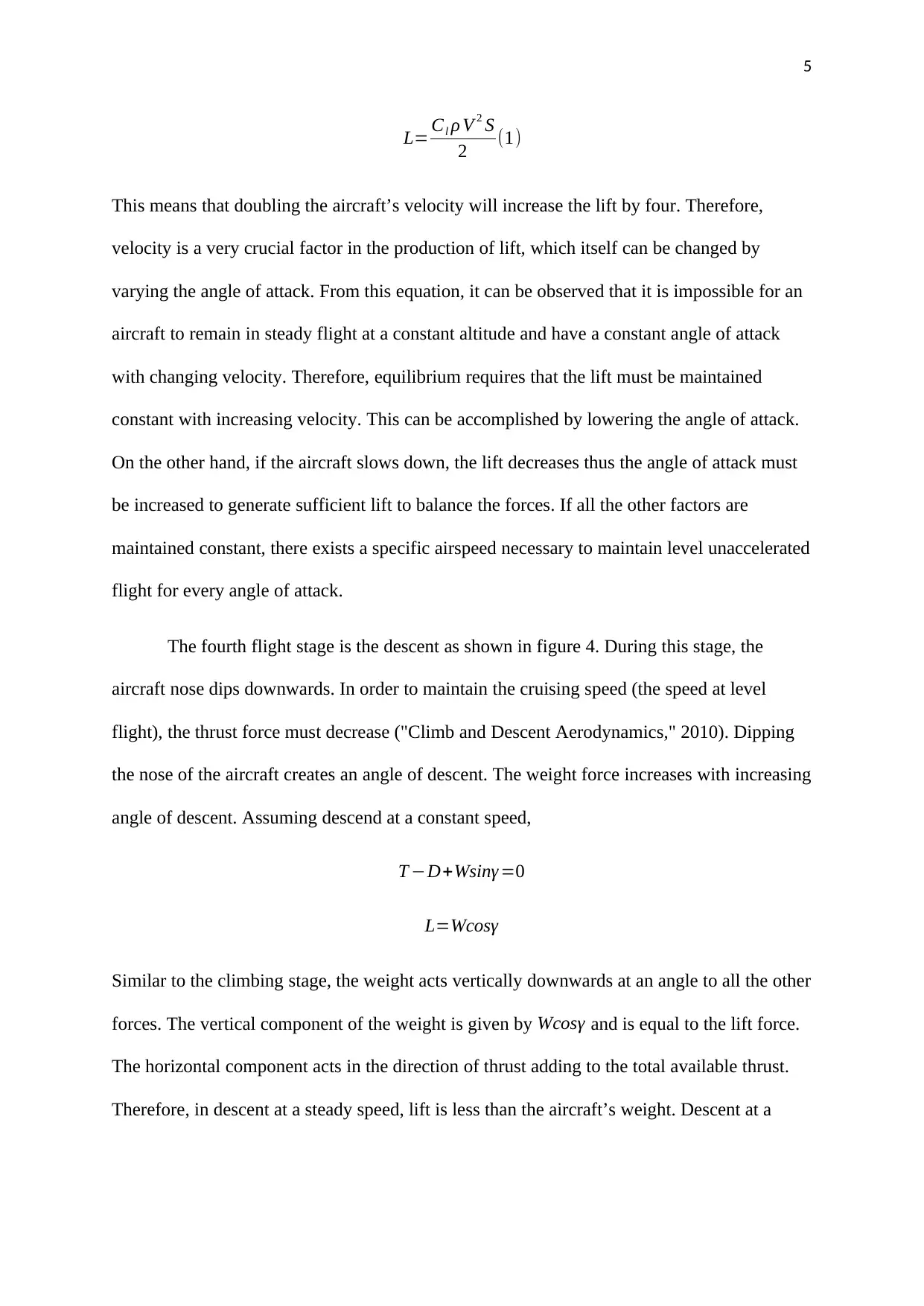
5
L= Cl ρ V 2 S
2 (1)
This means that doubling the aircraft’s velocity will increase the lift by four. Therefore,
velocity is a very crucial factor in the production of lift, which itself can be changed by
varying the angle of attack. From this equation, it can be observed that it is impossible for an
aircraft to remain in steady flight at a constant altitude and have a constant angle of attack
with changing velocity. Therefore, equilibrium requires that the lift must be maintained
constant with increasing velocity. This can be accomplished by lowering the angle of attack.
On the other hand, if the aircraft slows down, the lift decreases thus the angle of attack must
be increased to generate sufficient lift to balance the forces. If all the other factors are
maintained constant, there exists a specific airspeed necessary to maintain level unaccelerated
flight for every angle of attack.
The fourth flight stage is the descent as shown in figure 4. During this stage, the
aircraft nose dips downwards. In order to maintain the cruising speed (the speed at level
flight), the thrust force must decrease ("Climb and Descent Aerodynamics," 2010). Dipping
the nose of the aircraft creates an angle of descent. The weight force increases with increasing
angle of descent. Assuming descend at a constant speed,
T −D+Wsinγ =0
L=Wcosγ
Similar to the climbing stage, the weight acts vertically downwards at an angle to all the other
forces. The vertical component of the weight is given by Wcosγ and is equal to the lift force.
The horizontal component acts in the direction of thrust adding to the total available thrust.
Therefore, in descent at a steady speed, lift is less than the aircraft’s weight. Descent at a
L= Cl ρ V 2 S
2 (1)
This means that doubling the aircraft’s velocity will increase the lift by four. Therefore,
velocity is a very crucial factor in the production of lift, which itself can be changed by
varying the angle of attack. From this equation, it can be observed that it is impossible for an
aircraft to remain in steady flight at a constant altitude and have a constant angle of attack
with changing velocity. Therefore, equilibrium requires that the lift must be maintained
constant with increasing velocity. This can be accomplished by lowering the angle of attack.
On the other hand, if the aircraft slows down, the lift decreases thus the angle of attack must
be increased to generate sufficient lift to balance the forces. If all the other factors are
maintained constant, there exists a specific airspeed necessary to maintain level unaccelerated
flight for every angle of attack.
The fourth flight stage is the descent as shown in figure 4. During this stage, the
aircraft nose dips downwards. In order to maintain the cruising speed (the speed at level
flight), the thrust force must decrease ("Climb and Descent Aerodynamics," 2010). Dipping
the nose of the aircraft creates an angle of descent. The weight force increases with increasing
angle of descent. Assuming descend at a constant speed,
T −D+Wsinγ =0
L=Wcosγ
Similar to the climbing stage, the weight acts vertically downwards at an angle to all the other
forces. The vertical component of the weight is given by Wcosγ and is equal to the lift force.
The horizontal component acts in the direction of thrust adding to the total available thrust.
Therefore, in descent at a steady speed, lift is less than the aircraft’s weight. Descent at a
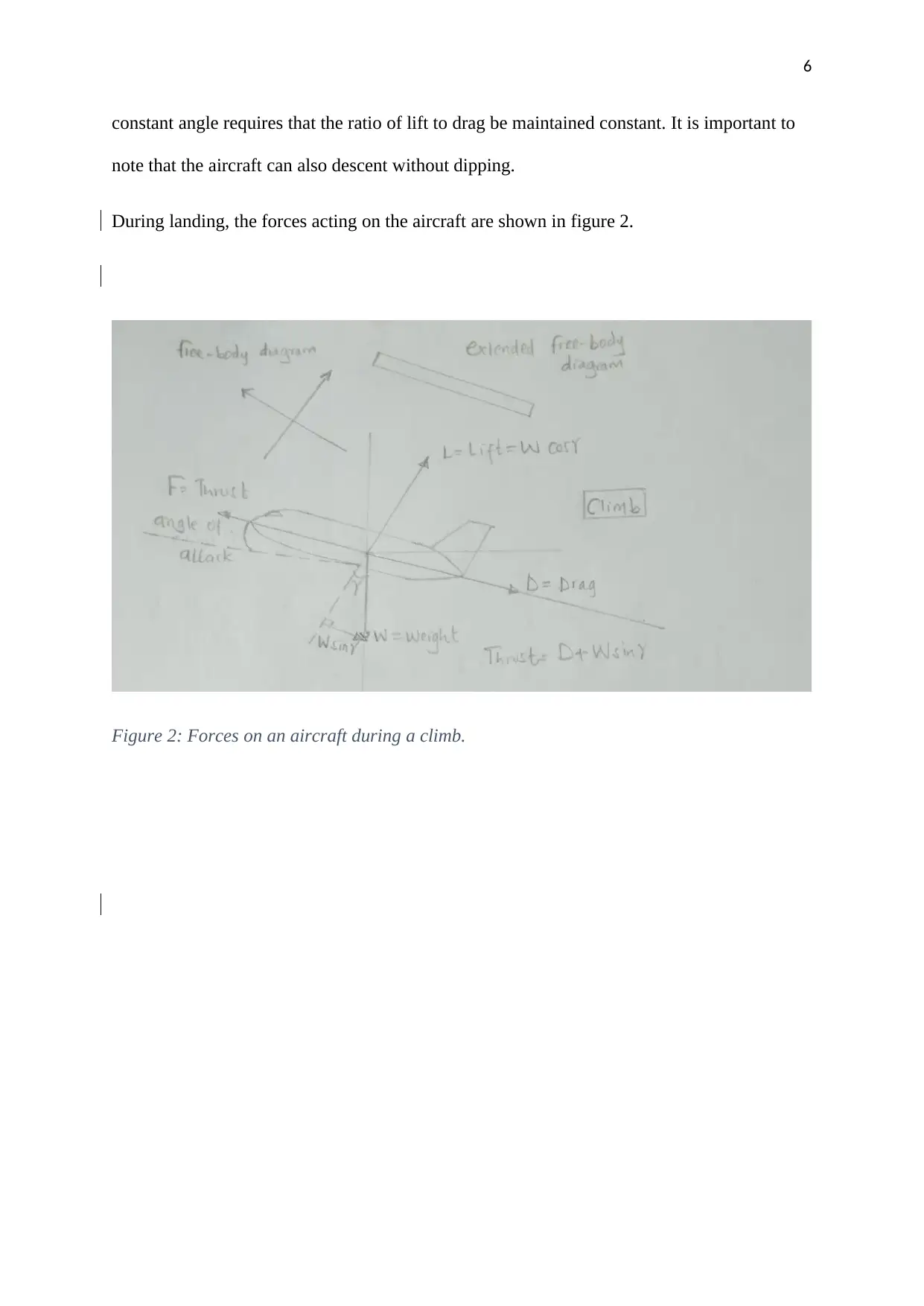
6
constant angle requires that the ratio of lift to drag be maintained constant. It is important to
note that the aircraft can also descent without dipping.
During landing, the forces acting on the aircraft are shown in figure 2.
Figure 2: Forces on an aircraft during a climb.
constant angle requires that the ratio of lift to drag be maintained constant. It is important to
note that the aircraft can also descent without dipping.
During landing, the forces acting on the aircraft are shown in figure 2.
Figure 2: Forces on an aircraft during a climb.
⊘ This is a preview!⊘
Do you want full access?
Subscribe today to unlock all pages.

Trusted by 1+ million students worldwide
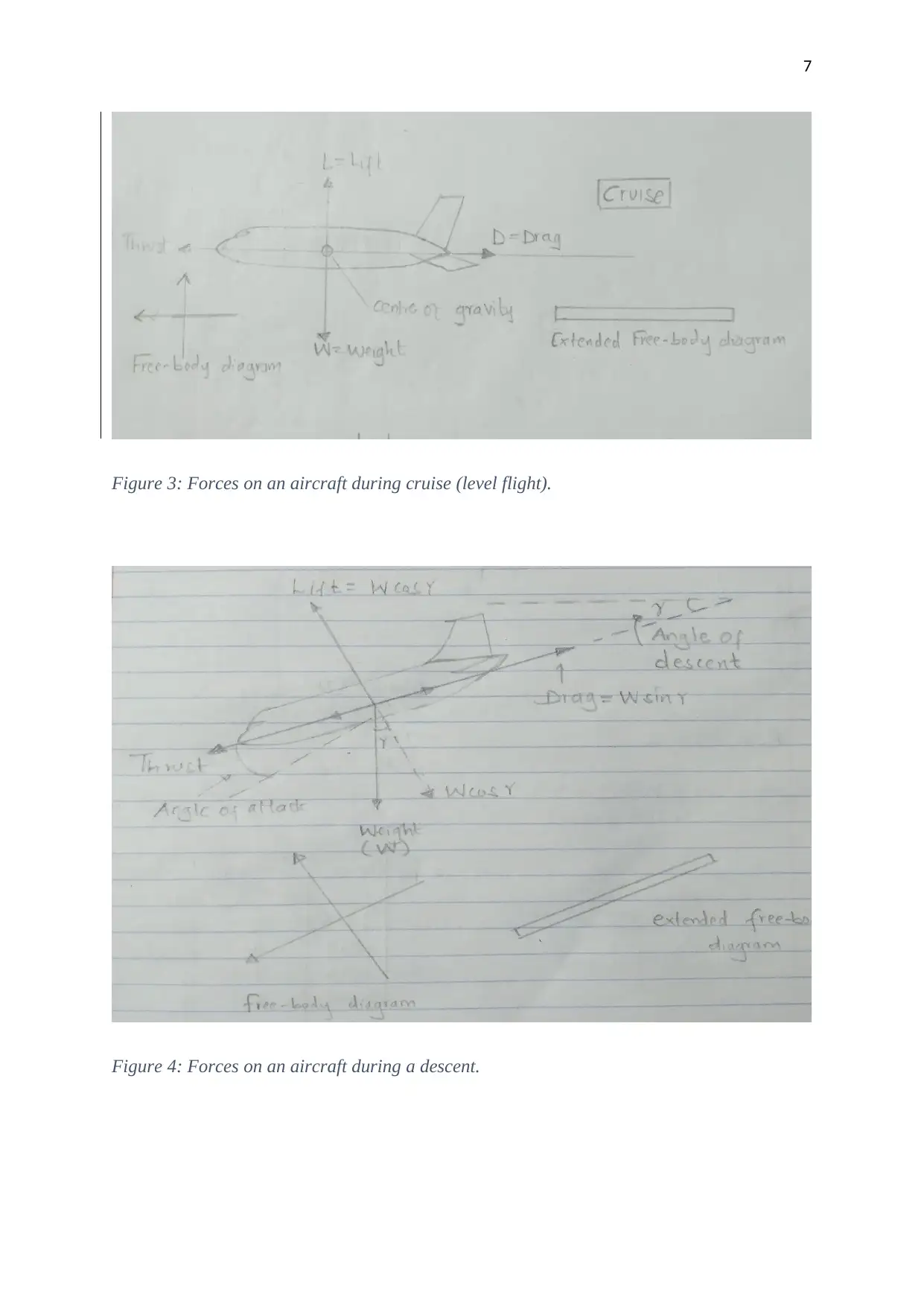
7
Figure 3: Forces on an aircraft during cruise (level flight).
Figure 4: Forces on an aircraft during a descent.
Figure 3: Forces on an aircraft during cruise (level flight).
Figure 4: Forces on an aircraft during a descent.
Paraphrase This Document
Need a fresh take? Get an instant paraphrase of this document with our AI Paraphraser
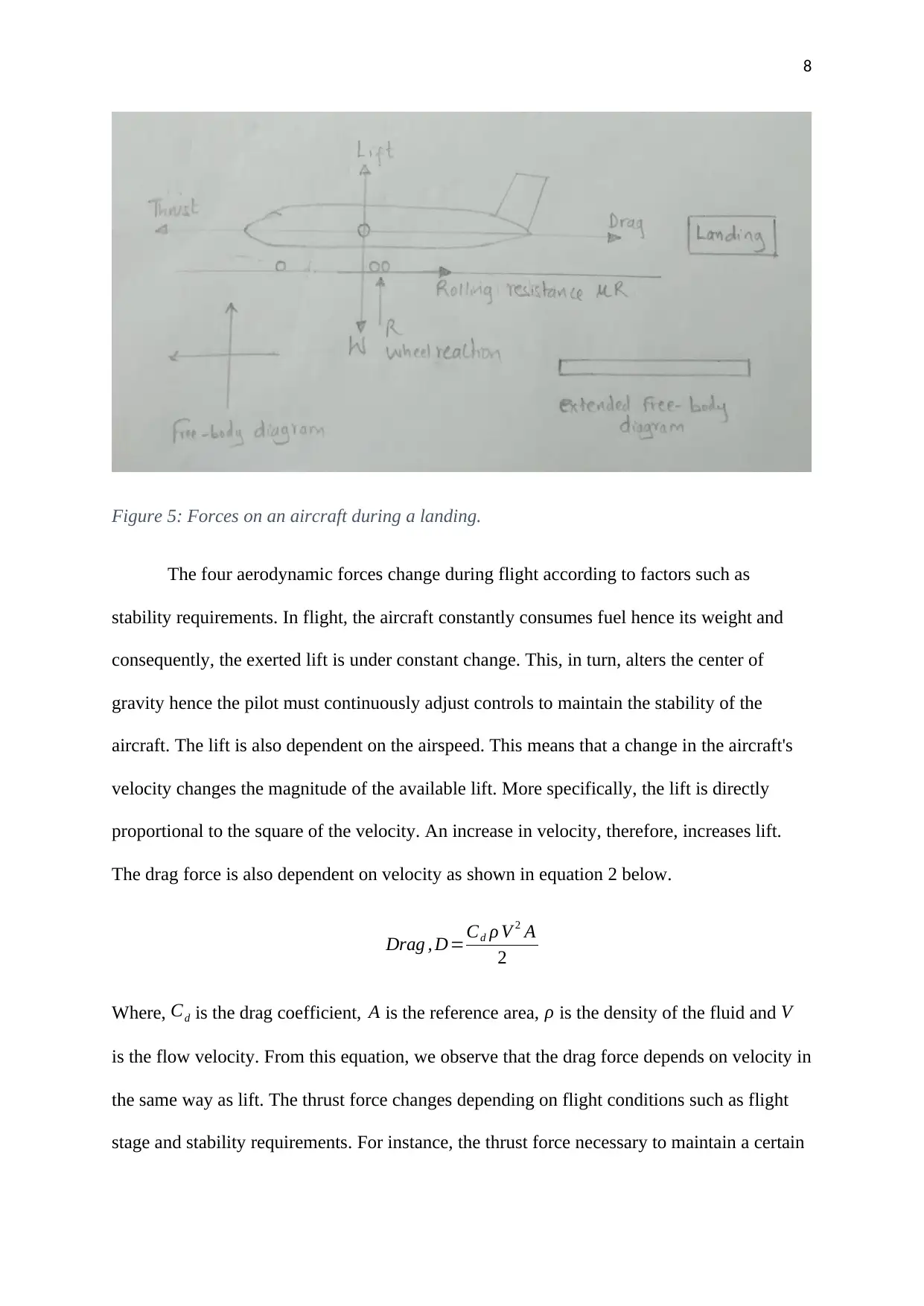
8
Figure 5: Forces on an aircraft during a landing.
The four aerodynamic forces change during flight according to factors such as
stability requirements. In flight, the aircraft constantly consumes fuel hence its weight and
consequently, the exerted lift is under constant change. This, in turn, alters the center of
gravity hence the pilot must continuously adjust controls to maintain the stability of the
aircraft. The lift is also dependent on the airspeed. This means that a change in the aircraft's
velocity changes the magnitude of the available lift. More specifically, the lift is directly
proportional to the square of the velocity. An increase in velocity, therefore, increases lift.
The drag force is also dependent on velocity as shown in equation 2 below.
Drag , D=Cd ρ V 2 A
2
Where, Cd is the drag coefficient, A is the reference area, ρ is the density of the fluid and V
is the flow velocity. From this equation, we observe that the drag force depends on velocity in
the same way as lift. The thrust force changes depending on flight conditions such as flight
stage and stability requirements. For instance, the thrust force necessary to maintain a certain
Figure 5: Forces on an aircraft during a landing.
The four aerodynamic forces change during flight according to factors such as
stability requirements. In flight, the aircraft constantly consumes fuel hence its weight and
consequently, the exerted lift is under constant change. This, in turn, alters the center of
gravity hence the pilot must continuously adjust controls to maintain the stability of the
aircraft. The lift is also dependent on the airspeed. This means that a change in the aircraft's
velocity changes the magnitude of the available lift. More specifically, the lift is directly
proportional to the square of the velocity. An increase in velocity, therefore, increases lift.
The drag force is also dependent on velocity as shown in equation 2 below.
Drag , D=Cd ρ V 2 A
2
Where, Cd is the drag coefficient, A is the reference area, ρ is the density of the fluid and V
is the flow velocity. From this equation, we observe that the drag force depends on velocity in
the same way as lift. The thrust force changes depending on flight conditions such as flight
stage and stability requirements. For instance, the thrust force necessary to maintain a certain
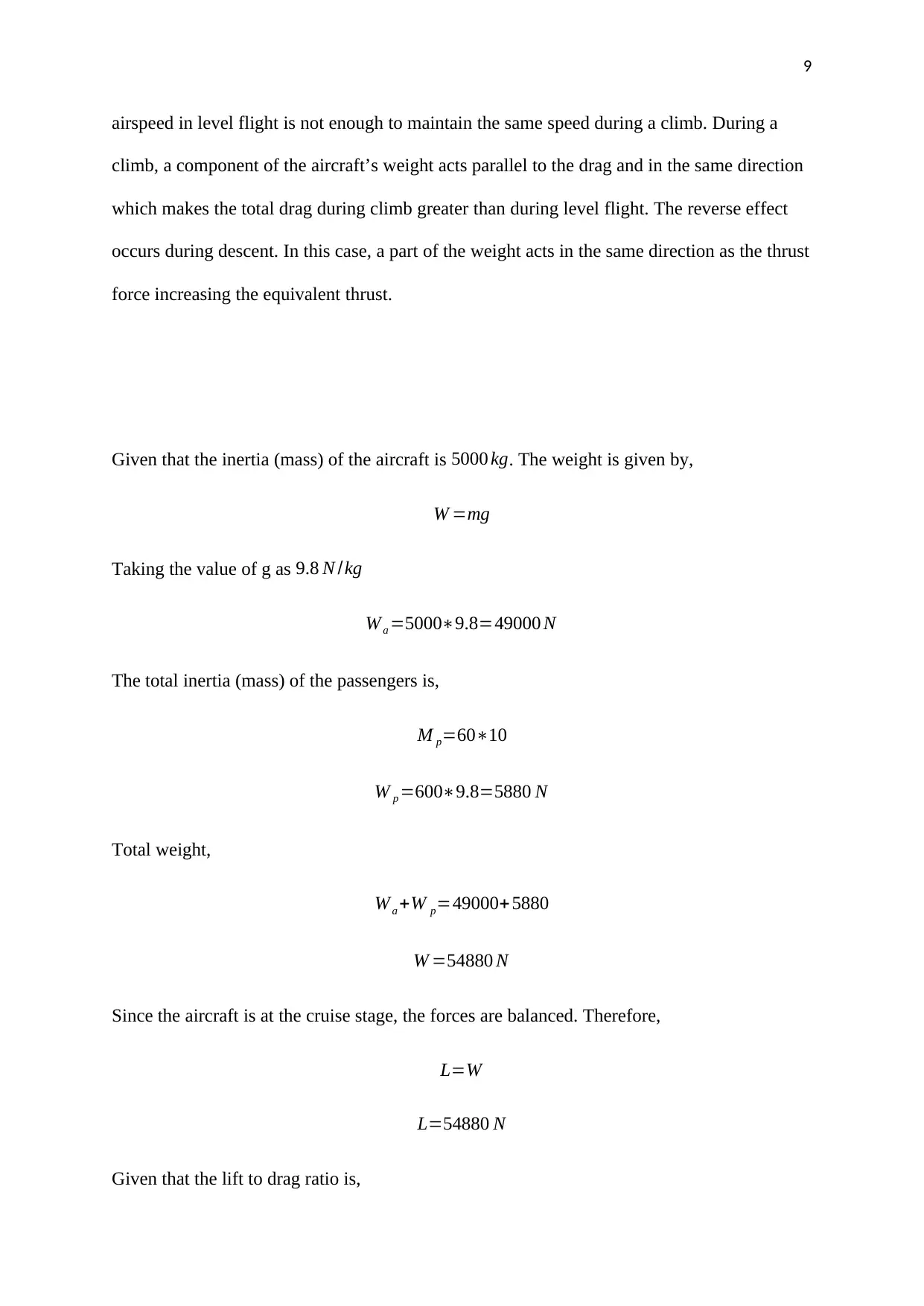
9
airspeed in level flight is not enough to maintain the same speed during a climb. During a
climb, a component of the aircraft’s weight acts parallel to the drag and in the same direction
which makes the total drag during climb greater than during level flight. The reverse effect
occurs during descent. In this case, a part of the weight acts in the same direction as the thrust
force increasing the equivalent thrust.
Given that the inertia (mass) of the aircraft is 5000 kg. The weight is given by,
W =mg
Taking the value of g as 9.8 N /kg
W a =5000∗9.8=49000 N
The total inertia (mass) of the passengers is,
M p=60∗10
W p =600∗9.8=5880 N
Total weight,
W a +W p=49000+ 5880
W =54880 N
Since the aircraft is at the cruise stage, the forces are balanced. Therefore,
L=W
L=54880 N
Given that the lift to drag ratio is,
airspeed in level flight is not enough to maintain the same speed during a climb. During a
climb, a component of the aircraft’s weight acts parallel to the drag and in the same direction
which makes the total drag during climb greater than during level flight. The reverse effect
occurs during descent. In this case, a part of the weight acts in the same direction as the thrust
force increasing the equivalent thrust.
Given that the inertia (mass) of the aircraft is 5000 kg. The weight is given by,
W =mg
Taking the value of g as 9.8 N /kg
W a =5000∗9.8=49000 N
The total inertia (mass) of the passengers is,
M p=60∗10
W p =600∗9.8=5880 N
Total weight,
W a +W p=49000+ 5880
W =54880 N
Since the aircraft is at the cruise stage, the forces are balanced. Therefore,
L=W
L=54880 N
Given that the lift to drag ratio is,
⊘ This is a preview!⊘
Do you want full access?
Subscribe today to unlock all pages.

Trusted by 1+ million students worldwide
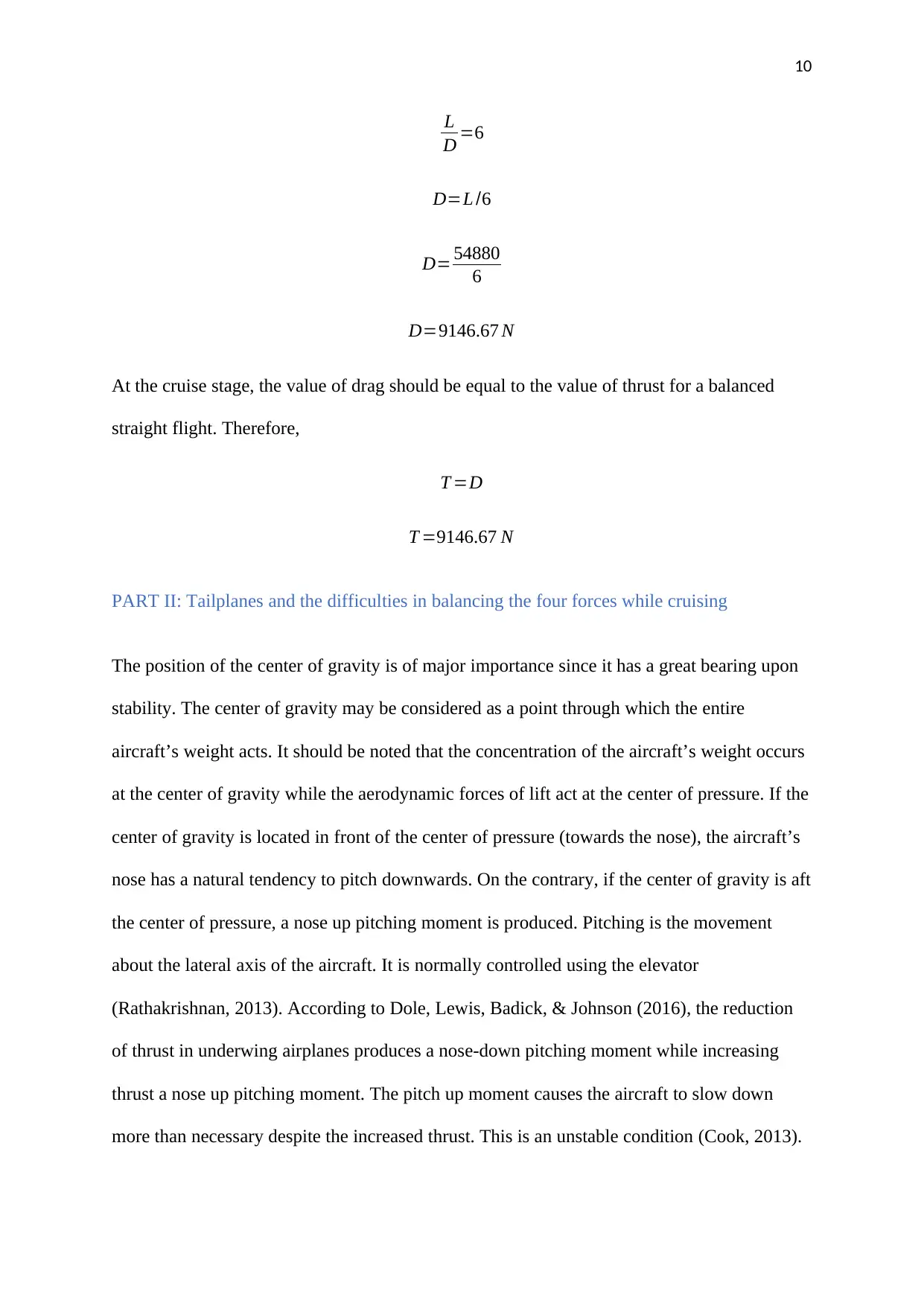
10
L
D =6
D=L /6
D= 54880
6
D=9146.67 N
At the cruise stage, the value of drag should be equal to the value of thrust for a balanced
straight flight. Therefore,
T =D
T =9146.67 N
PART II: Tailplanes and the difficulties in balancing the four forces while cruising
The position of the center of gravity is of major importance since it has a great bearing upon
stability. The center of gravity may be considered as a point through which the entire
aircraft’s weight acts. It should be noted that the concentration of the aircraft’s weight occurs
at the center of gravity while the aerodynamic forces of lift act at the center of pressure. If the
center of gravity is located in front of the center of pressure (towards the nose), the aircraft’s
nose has a natural tendency to pitch downwards. On the contrary, if the center of gravity is aft
the center of pressure, a nose up pitching moment is produced. Pitching is the movement
about the lateral axis of the aircraft. It is normally controlled using the elevator
(Rathakrishnan, 2013). According to Dole, Lewis, Badick, & Johnson (2016), the reduction
of thrust in underwing airplanes produces a nose-down pitching moment while increasing
thrust a nose up pitching moment. The pitch up moment causes the aircraft to slow down
more than necessary despite the increased thrust. This is an unstable condition (Cook, 2013).
L
D =6
D=L /6
D= 54880
6
D=9146.67 N
At the cruise stage, the value of drag should be equal to the value of thrust for a balanced
straight flight. Therefore,
T =D
T =9146.67 N
PART II: Tailplanes and the difficulties in balancing the four forces while cruising
The position of the center of gravity is of major importance since it has a great bearing upon
stability. The center of gravity may be considered as a point through which the entire
aircraft’s weight acts. It should be noted that the concentration of the aircraft’s weight occurs
at the center of gravity while the aerodynamic forces of lift act at the center of pressure. If the
center of gravity is located in front of the center of pressure (towards the nose), the aircraft’s
nose has a natural tendency to pitch downwards. On the contrary, if the center of gravity is aft
the center of pressure, a nose up pitching moment is produced. Pitching is the movement
about the lateral axis of the aircraft. It is normally controlled using the elevator
(Rathakrishnan, 2013). According to Dole, Lewis, Badick, & Johnson (2016), the reduction
of thrust in underwing airplanes produces a nose-down pitching moment while increasing
thrust a nose up pitching moment. The pitch up moment causes the aircraft to slow down
more than necessary despite the increased thrust. This is an unstable condition (Cook, 2013).
Paraphrase This Document
Need a fresh take? Get an instant paraphrase of this document with our AI Paraphraser
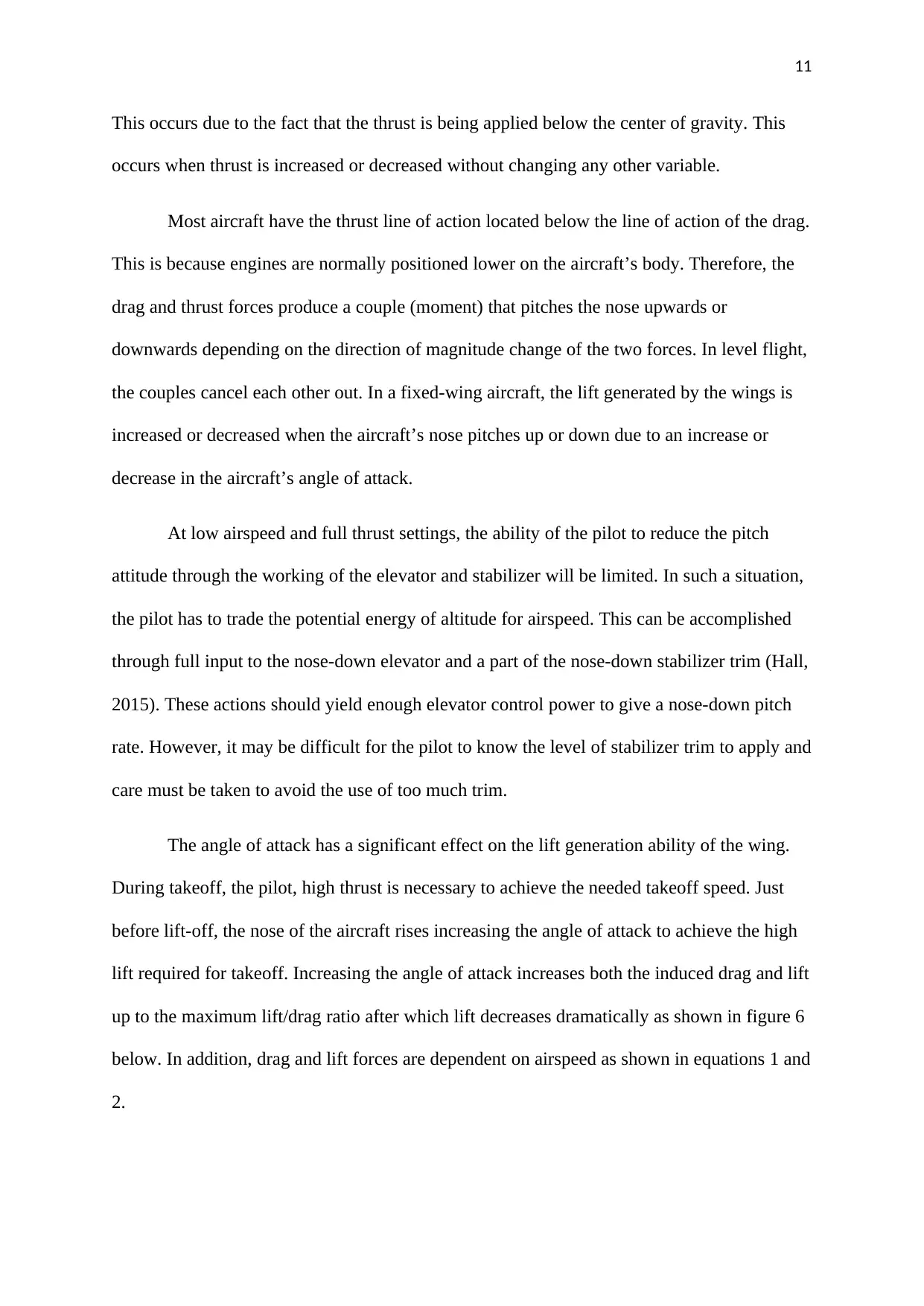
11
This occurs due to the fact that the thrust is being applied below the center of gravity. This
occurs when thrust is increased or decreased without changing any other variable.
Most aircraft have the thrust line of action located below the line of action of the drag.
This is because engines are normally positioned lower on the aircraft’s body. Therefore, the
drag and thrust forces produce a couple (moment) that pitches the nose upwards or
downwards depending on the direction of magnitude change of the two forces. In level flight,
the couples cancel each other out. In a fixed-wing aircraft, the lift generated by the wings is
increased or decreased when the aircraft’s nose pitches up or down due to an increase or
decrease in the aircraft’s angle of attack.
At low airspeed and full thrust settings, the ability of the pilot to reduce the pitch
attitude through the working of the elevator and stabilizer will be limited. In such a situation,
the pilot has to trade the potential energy of altitude for airspeed. This can be accomplished
through full input to the nose-down elevator and a part of the nose-down stabilizer trim (Hall,
2015). These actions should yield enough elevator control power to give a nose-down pitch
rate. However, it may be difficult for the pilot to know the level of stabilizer trim to apply and
care must be taken to avoid the use of too much trim.
The angle of attack has a significant effect on the lift generation ability of the wing.
During takeoff, the pilot, high thrust is necessary to achieve the needed takeoff speed. Just
before lift-off, the nose of the aircraft rises increasing the angle of attack to achieve the high
lift required for takeoff. Increasing the angle of attack increases both the induced drag and lift
up to the maximum lift/drag ratio after which lift decreases dramatically as shown in figure 6
below. In addition, drag and lift forces are dependent on airspeed as shown in equations 1 and
2.
This occurs due to the fact that the thrust is being applied below the center of gravity. This
occurs when thrust is increased or decreased without changing any other variable.
Most aircraft have the thrust line of action located below the line of action of the drag.
This is because engines are normally positioned lower on the aircraft’s body. Therefore, the
drag and thrust forces produce a couple (moment) that pitches the nose upwards or
downwards depending on the direction of magnitude change of the two forces. In level flight,
the couples cancel each other out. In a fixed-wing aircraft, the lift generated by the wings is
increased or decreased when the aircraft’s nose pitches up or down due to an increase or
decrease in the aircraft’s angle of attack.
At low airspeed and full thrust settings, the ability of the pilot to reduce the pitch
attitude through the working of the elevator and stabilizer will be limited. In such a situation,
the pilot has to trade the potential energy of altitude for airspeed. This can be accomplished
through full input to the nose-down elevator and a part of the nose-down stabilizer trim (Hall,
2015). These actions should yield enough elevator control power to give a nose-down pitch
rate. However, it may be difficult for the pilot to know the level of stabilizer trim to apply and
care must be taken to avoid the use of too much trim.
The angle of attack has a significant effect on the lift generation ability of the wing.
During takeoff, the pilot, high thrust is necessary to achieve the needed takeoff speed. Just
before lift-off, the nose of the aircraft rises increasing the angle of attack to achieve the high
lift required for takeoff. Increasing the angle of attack increases both the induced drag and lift
up to the maximum lift/drag ratio after which lift decreases dramatically as shown in figure 6
below. In addition, drag and lift forces are dependent on airspeed as shown in equations 1 and
2.
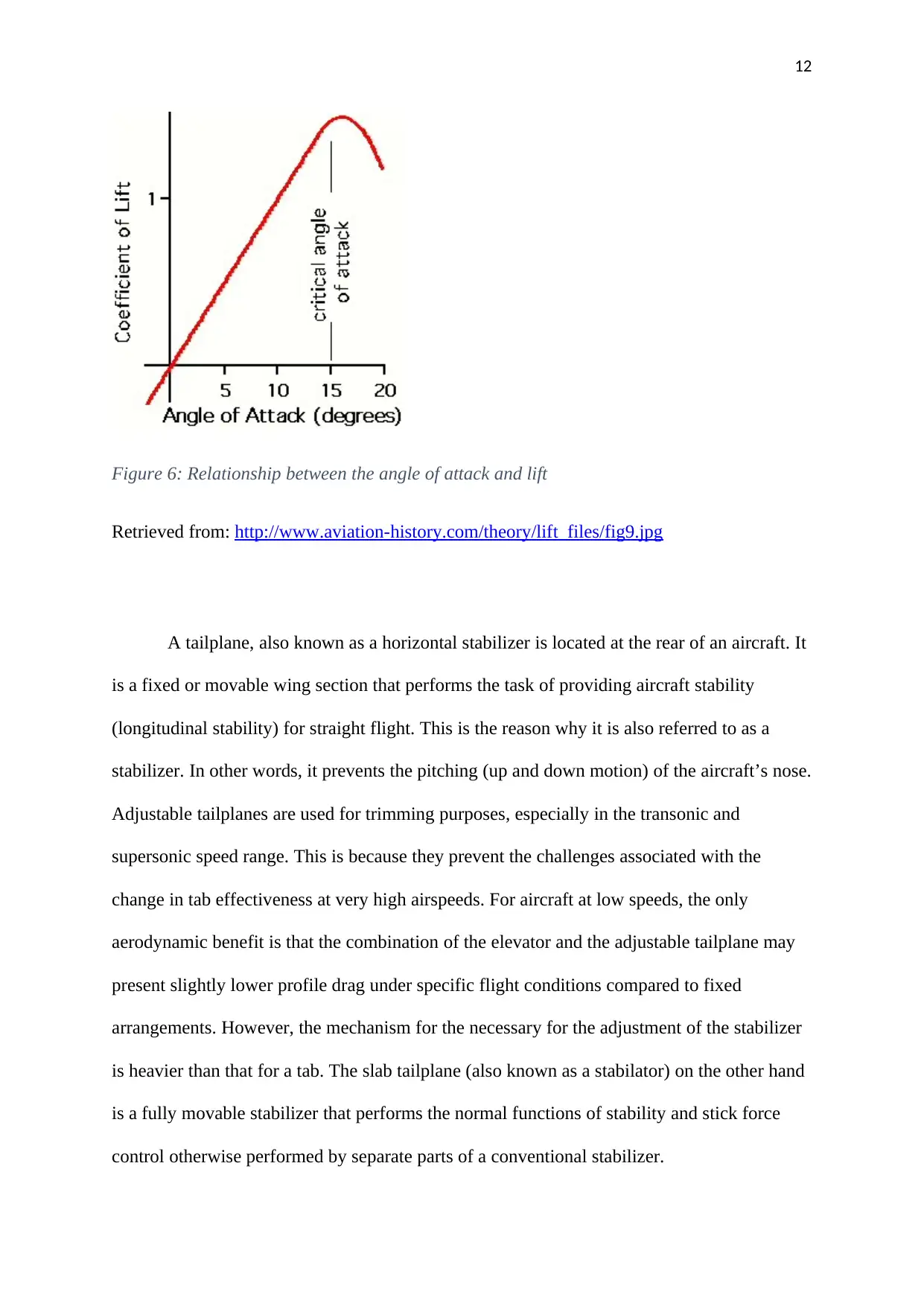
12
Figure 6: Relationship between the angle of attack and lift
Retrieved from: http://www.aviation-history.com/theory/lift_files/fig9.jpg
A tailplane, also known as a horizontal stabilizer is located at the rear of an aircraft. It
is a fixed or movable wing section that performs the task of providing aircraft stability
(longitudinal stability) for straight flight. This is the reason why it is also referred to as a
stabilizer. In other words, it prevents the pitching (up and down motion) of the aircraft’s nose.
Adjustable tailplanes are used for trimming purposes, especially in the transonic and
supersonic speed range. This is because they prevent the challenges associated with the
change in tab effectiveness at very high airspeeds. For aircraft at low speeds, the only
aerodynamic benefit is that the combination of the elevator and the adjustable tailplane may
present slightly lower profile drag under specific flight conditions compared to fixed
arrangements. However, the mechanism for the necessary for the adjustment of the stabilizer
is heavier than that for a tab. The slab tailplane (also known as a stabilator) on the other hand
is a fully movable stabilizer that performs the normal functions of stability and stick force
control otherwise performed by separate parts of a conventional stabilizer.
Figure 6: Relationship between the angle of attack and lift
Retrieved from: http://www.aviation-history.com/theory/lift_files/fig9.jpg
A tailplane, also known as a horizontal stabilizer is located at the rear of an aircraft. It
is a fixed or movable wing section that performs the task of providing aircraft stability
(longitudinal stability) for straight flight. This is the reason why it is also referred to as a
stabilizer. In other words, it prevents the pitching (up and down motion) of the aircraft’s nose.
Adjustable tailplanes are used for trimming purposes, especially in the transonic and
supersonic speed range. This is because they prevent the challenges associated with the
change in tab effectiveness at very high airspeeds. For aircraft at low speeds, the only
aerodynamic benefit is that the combination of the elevator and the adjustable tailplane may
present slightly lower profile drag under specific flight conditions compared to fixed
arrangements. However, the mechanism for the necessary for the adjustment of the stabilizer
is heavier than that for a tab. The slab tailplane (also known as a stabilator) on the other hand
is a fully movable stabilizer that performs the normal functions of stability and stick force
control otherwise performed by separate parts of a conventional stabilizer.
⊘ This is a preview!⊘
Do you want full access?
Subscribe today to unlock all pages.

Trusted by 1+ million students worldwide
1 out of 17
Related Documents
Your All-in-One AI-Powered Toolkit for Academic Success.
+13062052269
info@desklib.com
Available 24*7 on WhatsApp / Email
![[object Object]](/_next/static/media/star-bottom.7253800d.svg)
Unlock your academic potential
Copyright © 2020–2025 A2Z Services. All Rights Reserved. Developed and managed by ZUCOL.





